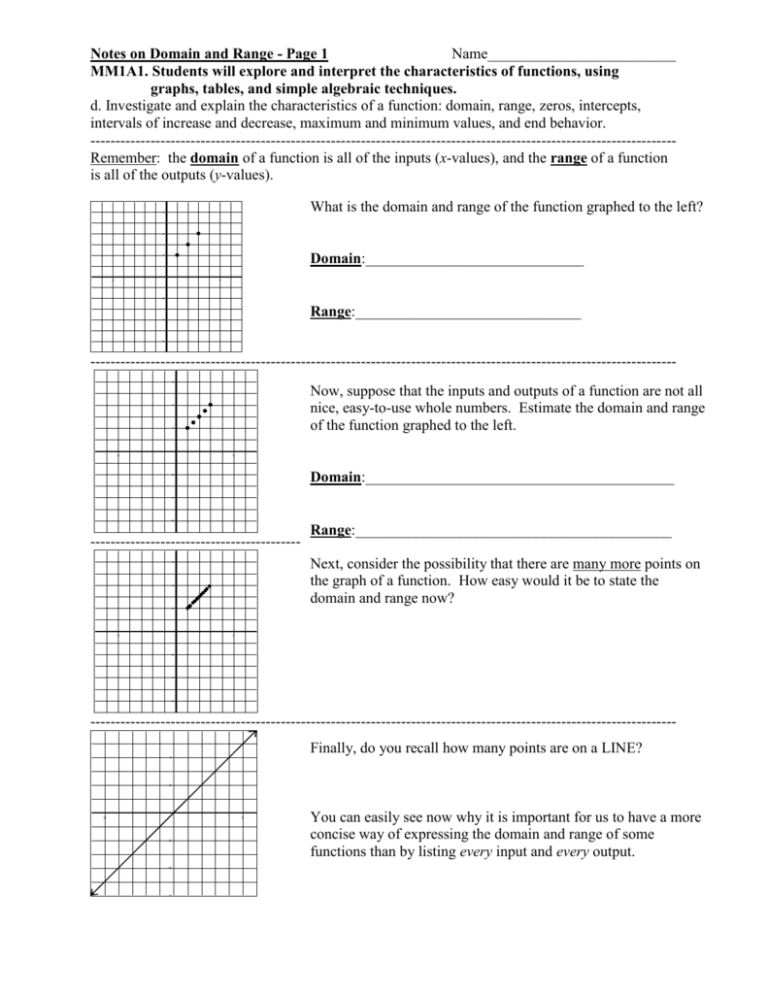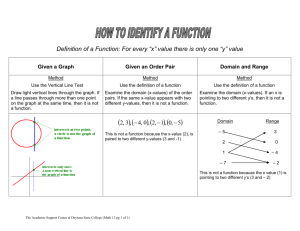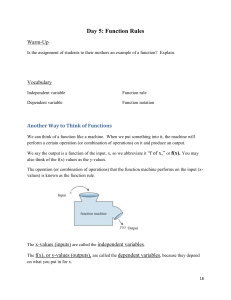1 Notes and HW on Domain and Range
advertisement

Notes on Domain and Range - Page 1
Name_________________________
MM1A1. Students will explore and interpret the characteristics of functions, using
graphs, tables, and simple algebraic techniques.
d. Investigate and explain the characteristics of a function: domain, range, zeros, intercepts,
intervals of increase and decrease, maximum and minimum values, and end behavior.
--------------------------------------------------------------------------------------------------------------------Remember: the domain of a function is all of the inputs (x-values), and the range of a function
is all of the outputs (y-values).
What is the domain and range of the function graphed to the left?
6
4
Domain:_____________________________
2
-5
5
-2
Range:______________________________
-4
-6
--------------------------------------------------------------------------------------------------------------------6
Now, suppose that the inputs and outputs of a function are not all
nice, easy-to-use whole numbers. Estimate the domain and range
of the function graphed to the left.
4
2
-5
5
Domain:_________________________________________
-2
-4
-6
Range:__________________________________________
--------------------------------------------------------------------------------------------------------------------Next, consider the possibility that there are many more points on
the graph of a function. How easy would it be to state the
domain and range now?
6
4
2
-5
5
-2
-4
-6
--------------------------------------------------------------------------------------------------------------------Finally, do you recall how many points are on a LINE?
4
2
-5
5
-2
-4
-6
You can easily see now why it is important for us to have a more
concise way of expressing the domain and range of some
functions than by listing every input and every output.
Discrete functions are functions in which the entire domain and range can be listed. The graphs
of discrete functions will look like a series of points that are NOT connected.
Which of the functions graphed on the other side of the paper are discrete functions?
In all continuous functions, it is impossible to list all of the elements of the domain and range.
The graphs of continuous functions involve some type of segment, line, or curve that is one
piece. It is like the points that ARE connected.
Which of the functions graphed on the other side of the paper are continuous functions?
--------------------------------------------------------------------------------------------------------------------To express the domains and ranges of continuous functions, since we can't list every value, we
we use interval notation.
For example, suppose the domain of a function is every possible input, or x-value, that is greater
than 5. "6" is in the domain, "10" is in the domain, "1,000,000" is in the domain, "5.135342" is
in the domain, "11.9" is in the domain, and so on. The interval notation to represent this domain
is (5, ∞)
Suppose the range of a function is all y-values that are less than 4, that is (-∞, 4)
Is "5" in the range?_______
Is "-4" in the range?_______
Is "0" in the range? _______
Is "2" in the range?_______
Is "3.7" in the range?_______
Is "4" in the range?_______
--------------------------------------------------------------------------------------------------------------------This, of course, leads one to the all-important question: how do I, by looking at the graph of a
continuous function, state the domain and range using interval notation?
Well, let us begin by considering the domain. Remember again that the domain represents
x-values. So, when we want the domain, we want every x-coordinate of every point that makes
up the graph of a function. Do the x-coordinates affect how far left/right a point is or how far
low/high a point is?
Therefore, when finding the domain of a continuous function, I am going to look ___________.
--------------------------------------------------------------------------------------------------------------------When finding the range, we will want every y-coordinate of every point.
Thus, when finding the range of a continuous function I am going to look ________________.
IMPORTANT: If a low/high point for range or left/right point for domain is included as a part
of the range or domain (there is a closed dot on the point), we use brackets, “ [ ” or “ ] ”, instead
of parenthesis. If the dot on the point is open, that means the point is not included in the domain
and/or range, therefore we use parenthesis, “ ( “ or “ ) ”. Always use parenthesis around the
infinity sign.
Notes on Domain and Range - Page 2
Name_________________________
The best way to illustrate this process is by practicing some problems. Consider the graph of the
function below:
Let's begin by thinking about the domain of this function.
6
What is the lowest x-value in the domain? In other words,
how far left does this graph go?
4
2
What is the highest x-value in the domain? In other words,
how far right does this graph go?
-5
5
-2
Is every number between these two values in the domain?
-4
-6
Then, what is the domain?
Now, try to find the range by going through the same process, except from low to high.
--------------------------------------------------------------------------------------------------------------------Find the domain again.
6
4
How far left does the graph go?
2
How far right does the graph go?
-5
5
Is every number between these two values in the domain?
-2
-4
Then, what is the domain?
-6
Find the range now.
How low does the graph go (y-values remember)?
How high does the graph go?
Is every number between these two values in the range?
Then, what is the range?
--------------------------------------------------------------------------------------------------------------------An open dot instead of a closed dot means that the function gets infinitely close to that point but
it does not include that point. When there are open dots, one will use a “( ” or “)” sign.
6
What is the domain?
4
2
-5
What is the range?
5
-2
-4
-6
Homework on Domain and Range
Name_______________________________
For the graphs of each of the functions, A)state whether the function is discrete or continuous, and B)state the
domain and range of the function. REMEMBER - if the function is discrete, you should simply list all of the values
for the domain and range. If it is continuous, you will probably have to use inequalities.
Another hint - #5 will require two inequalities for both the domain and range - do not label it as discrete or
continuous (why?)
1.
2.
3.
6
6
6
4
4
4
2
2
2
-5
5
-5
5
-5
5
-2
-2
-2
-4
-4
-4
-6
-6
-6
4.
5.
6.
6
6
6
4
4
4
2
2
2
-5
5
-5
5
-5
5
-2
-2
-2
-4
-4
-4
-6
-6
-6
7.
8.
9.
6
6
6
4
4
4
2
2
2
-5
5
-5
5
-5
5
-2
-2
-2
-4
-4
-4
-6
-6
-6
-------------------------------------------------------------------------------------------------------------------------------------------1. continuous; D: (-3,2); R: (3,4)
2. continuous; D: [1,6] ; R: {-2} 3. continuous; D: (,) ; R: (,)
4. discrete; D: {1, 0,1, 2,3, 4} ; R: {0,1, 2,3,5} 5. D: [3,1] and [2, 6] ; R: [3, 1]and [2,3]
6. continuous; D: (,) ; R: [-2, ∞) 7. continuous; D: (,) ; R: (,) 8. continuous; D: [0, ∞);
R: (-∞, -3] 9. continuous; D: (-∞, 2] ; R: {4}








